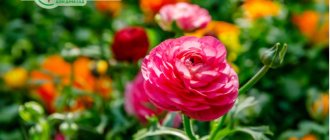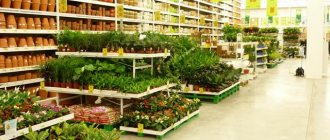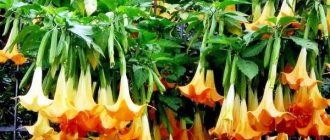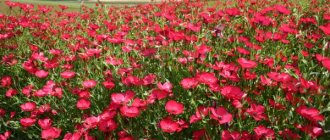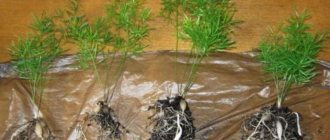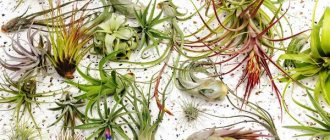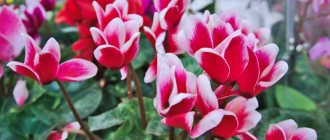Hyacinth is a bulbous plant with bright and fragrant flowering in early spring.
The flower is unique in that it can be successfully grown both in open ground and as an indoor flower that can be made to bloom at a certain time. Familiarity with the characteristics of a flower's growing season will help you learn how to grow at home and how to care for a plant.
Types of hyacinth
The genus Giacint unites only 3 species:
- hyacinth Oriental;
- hyacinth Litvinova;
- hyacinth Transcaspian.
In decorative floriculture, only Eastern hyacinth , characterized by:
- a dense, fleshy bulb, the color of the upper layer of scales of which, in its basic tone, correlates with the shade of the petals ;
- rosette leaves of linear or elongated oval shape with a pointed apex ;
- an erect peduncle rising to a height of up to 30 cm and bearing a racemose fragrant inflorescence formed by flowers with dense bell-shaped corollas.
Botanical description of the plant
The bulbs are hard and consist of watery scales. The peduncle has no leaves and reaches a length of up to thirty centimeters; as soon as it fades, it immediately dries out along with those that grow vertically. A bud is born in the very corner of the upper bulbous leaf, and a new hyacinth will grow from it next year.
The flowers are collected in a cone-shaped form. The perianth has slightly bent flower blades, a funnel-shaped shape, and is painted in bright colors. They differ in texture into terry and smooth. The seeds are in the fruit.
Popular varieties for indoor growing
Based on Eastern hyacinth, numerous hybrids , the descriptions of which differ:
- structure of the corollas: simple and terry ;
- petal color: white, yellow, orange, blue and purple, pink, red and black;
- Flowering dates: early, mid and late blooming.
Oriental hyacinth hybrids are unusually decorative; the Internet is replete with numerous photos of them. Most are suitable for growing indoors . The most common varieties found at home are:
- Ostara, with high (up to 30 cm) peduncles and loose purple inflorescences about 13 cm long, maintaining freshness for 3 weeks.
- Rosalia, different pink shades of inflorescences, consisting of 15-17 small (diameter 2 cm) buds with a short flowering period.
- Sunflower, with peduncles up to 20 cm high and medium-density cream inflorescences formed by small (3.5 cm) double flowers. Blooms for 2 weeks.
- Amethystcharacterized by a light purple color dense inflorescences up to 10 cm long and a one-week flowering period.
- La Victoire, which have gained popularity thanks to their dense inflorescences of spectacular bright red tones.
Actions after purchase
The desired container with a good, healthy flower was purchased and safely delivered home. The duration of the current flowering and the possibility of reusing the bulb depend on the correct home care.
Do I need to replant?
As a rule, the plant is brought from the store in a small pot with a small amount of substrate.
Hyacinth should be watered regularly during the flowering period; water should not get on the bulb; moisture should not stagnate. It is better to pour water into the pan.
A cramped store container will not be able to ensure normal moisture circulation.
The soil of the purchased plant in a pot is very poor and poor in mineral elements. Hyacinth will suffer from lack of nutrients. Therefore, a transplant is needed so that the hyacinth feels comfortable, blooms beautifully and makes a good reserve for the future.
Which container should you choose?
Choose a pot for transferring hyacinth, following the recommendations:
- A plastic, clay, ceramic pot is suitable;
- the main condition is the presence of drainage holes at the bottom;
- container size – depth 15 cm, diameter 9 cm for one onion;
- a drainage layer of fine expanded clay is poured onto the bottom, and a layer of clean sand on top;
- Loose, light, non-acidic soil, purchased specifically for bulbous plants, is placed on the drainage.
Drainage is extremely important for hyacinth; stagnation of water provokes rotting and death of the bulb .
Planting in another container
It is very important to carefully transfer the bulb along with a lump of earth into a new spacious container. This process is called transshipment. It is necessary to preserve the root system and rosette at the base of the bulb as much as possible.
Transshipment is done in one confident movement , preventing the root ball from scattering and exposing the roots. Sprinkle soil on top, leaving the top third of the bulb free. Spray the soil once with a weak solution of an antifungal agent.
Home care
In order to understand whether and how to grow hyacinth in an apartment , you need to get acquainted with the peculiarities of flower development.
The life cycle of hyacinth consists of 2 phases:
- the period of active growth occurring in spring and accompanied by the growth of leaves and flowering;
- a dormant period that occurs after flowering and lasts throughout autumn and winter. At this time , the ground part of the plant dies off , the flower exists at the level of the bulb.
In each period, hyacinth needs to create certain conditions and proper care.
Location and lighting
Hyacinth is a light-loving plant . For a successful growing season, it needs at least 15 hours of daylight, so at home it is better to place the flower on windows facing south or southeast .
On a sunny summer afternoon, the plant is darkened; in cloudy weather, as well as in early spring, it is additionally illuminated using phyto or fluorescent lamps .
During rest, the plant does not need light.
Temperature
One of the main conditions for optimal development and high-quality flowering of hyacinth is compliance with the temperature regime :
- during the active growing season, the flower needs moderate heat - 20, maximum 23 ° C ;
- complete rest, accompanied by the laying of flower buds, is possible only in cool weather - 15-17 degrees Celsius.
Attention! Hyacinth is sensitive to sudden temperature fluctuations and does not tolerate proximity to heating devices and the presence of drafts.
Watering and air humidity
Hyacinth loves water very much, so the soil in its pot should be slightly moist .
In indoor conditions, the plant is watered with water at room temperature that has been standing for 24 hours, rain water, or slightly warmed melt water.
The soil is moistened carefully , along the edge of the pot or from below, through a tray, trying not to get on the bulb, in the axils of the leaves and on the buds.
Important! With all their love for moisture, hyacinths grow only in an atmosphere of dry air and do not tolerate spraying.
The soil
To develop the bulb, hyacinth needs a nutrient substrate with a neutral environment, which can be used as a purchased universal flower soil or a mixture made independently.
Several options for its composition are possible:
- equal parts of humus or compost, peat, sand, leaf and turf soil;
- garden soil, peat and sand, taken in equal quantities;
- 2 parts of turf land, combined with 1 part of sand and one part of peat.
Experienced gardeners recommend adding perlite or vermiculite , which retain moisture and promote soil aeration.
Before planting, the soil is disinfected using one of the available methods:
- spill with a solution of phytosporin or potassium permanganate of medium concentration;
- calcined for half an hour in the oven;
- steam for 30 minutes.
Important . Preliminary soil treatment will avoid damage to the bulb by soil pests and reduce the risk of fungal diseases.
Where to place flowers
Hyacinth loves good lighting, so it is better to grow a flower near a south or east window. In addition, in the evening and cloudy weather, it is recommended to illuminate the plant with a phytolamp. Due to lack of light, the crop sheds its leaves, stops blooming and even withers. And for normal development, he needs 15 hours of daylight.
Hyacinth does not tolerate direct sunlight. Therefore, at noon in the summer, move the pots away from the window. In addition, do not forget to periodically turn the pot towards the light in different directions.
Feeding and fertilizers
Beautiful flowering of hyacinths is impossible without regular application of fertilizers , which use complex mineral additives for flowering or bulbous plants:
- fertilizing begins when the leaves grow, introducing mineral additives containing an increased amount of nitrogen ;
- in the future, until the end of flowering, fertilizers are applied 2 times a month , always after watering.
Advice! At the budding stage and during flowering, one of the fertilizers is replaced by adding a drug that stimulates flowering.
Problems and their solutions
Often gardeners are faced with the fact that the plant does not bloom or withers. In most cases, this is due to improper care of the crop. Helpful tips will help you correct the situation.
- If the plant has stopped blooming, then most likely it is too hot. Move the pot to a cool room and the culture will produce new buds.
- Yellowing foliage indicates that the crop is suffering due to improper watering. Drafts also lead to a similar phenomenon.
- The buds fall off if water gets on them when watering. Moisten the soil carefully. A similar problem is caused by irregular watering and hot conditions.
- The plant produces a short peduncle if it lacks light and nutrients in the soil. Place the pot in a sunny place and feed the crop, then it will recover.
- Hyacinth buds can rot if they are moistened too often. To correct the situation, reduce watering.
By following the advice given in the article, you will definitely achieve long-lasting and beautiful flowering from the plant. Provide the culture with comfortable conditions, and it will definitely reward you with an attractive appearance and pleasant aroma.
Choosing a bulb and forcing hyacinths
When grown artificially, hyacinth can be forced to bloom on a specific date . This process is called forcing. To carry it out, it is necessary to purchase and prepare planting material, substrate and containers in advance.
For forcing, extra-class bulbs are used , which differ in:
- large (from 5 cm in diameter) sizes;
- density;
- smooth surface without dents or bulges;
- uniform coloring of the scales, eliminating the presence of stains, inclusions and plaque .
The forcing bulb should have a small (1.5 times smaller than the diameter of the bulb) smooth and dry bottom , indicating its youth, and the rudiment of a cone-shaped sprout.
- Preparation of planting material: before planting, the bulbs are soaked for 1-2 hours in a weak solution of potassium permanganate, phytosporin (1 teaspoon per liter of water at room temperature) or any fungicide (Maxim, Vitaros), and then dried. After this, the bulbs are placed for 2 or weeks in a cool (5-7, maximum 8 ° C) place, for example, on the bottom shelf of the refrigerator.
- Containers: it is convenient to force hyacinths in small plastic pots 10-12 cm high, with drain holes and a drainage compartment. Clay and ceramic containers are not suitable, since the porous structure of their walls contributes to rapid cooling of the soil, which can lead to rotting of the bulb.
- The composition of the soil is selected based on the grower’s plans:
- a bulb used only for forcing can be planted in any substrate capable of holding roots. For a single flowering, its supply of nutrients is sufficient;
- in all cases involving the use of bulbs after forcing, planting is carried out in a nutrient mixture .
Forcing at home: step-by-step instructions
The process of home forcing of hyacinths is carried out according to the following scheme:
- Planting: the container is filled with substrate, leaving 1-1.5 cm to the edges , one or several (3-5 pieces) bulbs are placed on its surface at a distance of 1.5-2 cm, slightly (no more than 2/3) pressing bottom into the soil.
- Watering: carried out immediately after planting, along the edge of the pot or from below, through a tray; water should not fall on the bulb. If the soil settles after watering, top it up.
- Rooting: for the growth of roots and leaves, hyacinths need coolness and darkness , so the container with the bulbs is covered with thick dark paper and placed in a cool (5-9 degrees above zero) place for 40-45 days. Periodically, the containers are inspected and the soil is checked for moisture. It should not be allowed to dry out or become waterlogged . During this time, the flower should form roots and grow leaves 2.5-3 cm long.
- After 40-45 days, the flower is gradually, without removing the protective cap, transferred to a warm (12-15 ° C) place and kept in this form for 10 days. They adapt to light, as well as to heat, gradually; this is important for the acquisition of peduncle growth and the formation of a bud of the correct shape and rich color.
- On the 11th day, the plant is moved to a permanent, light and warm place (16-20 maximum 23 ° C). Within a month, the hyacinth will form a flower arrow with a bud and bloom .
This video shows how to force hyacinths at home.
How to get flowers at the right time
Many people are interested in the question of how to get hyacinths to bloom for a certain time. To do this, you need to first carry out some calculations and determine the start date of forcing :
- count back 2-3 weeks from the expected date of flowering to keep the bulbs cool;
- 40-45 days are added to the resulting date for germination in the dark;
- add 10 days for keeping in a warmer and darker place ;
- a month to form a flower arrow with a bud.
The result is 3-3.5 months. This means that if you want to get hyacinth blooming by March 8 , forcing should begin no later than mid-November, and if you plan to give blooming hyacinth as a gift for Valentine's Day - at the end of October, beginning of November .
6.Reproduction
Hyacinth bulbs usually live 4 - 6 years, so it is necessary to constantly propagate the plants by division . Reproduction is carried out by bulbs - children that form around the main bulb in late summer or early autumn.
Young bulbs try to bloom for the first time only after 3 - 4 years .
During the first 1 - 2 years, young bulbs are not allowed to bloom, breaking off the peduncle immediately after appearance. Thus, the bulbs gain strength and become larger.
Old bulbs can form large scales at the base - they can be separated and planted separately in a moist substrate under a cover made of transparent plastic or glass, at a temperature of about 20 ° C.
Young bulbs can form within a month.
↑ Up,
Caring for hyacinth after flowering
Faded hyacinths are often thrown away, considering that they are a single flowering plant. However, this is not so; after flowering, the life of the hyacinth does not end , even if it has gotten rid of the leaves and is only a bulb.
possible scenarios for caring for a flower after it blooms:
- classic care;
- rearing.
Classic care (the method is simple, but not always effective; often the bulbs dry out and become unsuitable for planting), which involves:
- pruning of the peduncle;
- stopping fertilizing and moistening the soil until the leaves dry and cutting them off at a distance of 1 cm from the top of the bulb;
- removing the bulbs from the pot, freeing them from the soil (can be washed) and the upper dark scales that come off naturally;
- disinfection with a solution of fundozol (according to the instructions) or low concentration of potassium permanganate and drying for a week at room temperature;
- storage in thick paper bags or boxes with sawdust for 2-3 months in a dark, dry and cool (13-15, maximum 17 degrees Celsius) place.
Reference! To avoid drying out, stored bulbs are checked once a month and sprayed with a weakly concentrated solution of phosphorus-potassium fertilizers.
An alternative method offered by indoor floriculture practitioners is growing hyacinth. For this:
- after cutting the peduncle, the plant is transplanted into a new, more spacious pot filled with fresh nutrient mixture;
- The container with the plant is placed in a slightly cool place (up to 20 °C), watered and fed regularly.
In areas with a warm climate, hyacinth that has become stronger after growing can be transplanted into open ground. If this is not possible, then it is better to place the flower in a slightly cool place: on a balcony or loggia, in a room, trying to create conditions as close as possible to natural ones. Over the summer, the bulb will gain strength and bloom again next spring.
This video gives tips on how to properly preserve hyacinth bulbs.
In areas with a warm climate, hyacinth that has become stronger after growing
can be transplanted into open ground .
If this is not possible, then it is better to place the flower in a slightly cool place: on a balcony or loggia , in a room, trying to create conditions as close as possible to natural ones. Over the summer, the bulb will gain strength and bloom again next spring .
Under what conditions will the plant bloom again in a year?
Plant forcing is done synthetically. In most cases, phytohormones are used, as well as synthetic stimulants that accelerate development. Due to accelerated growth, the hyacinth bulb is greatly depleted, and the supply of elements important for life that need to be replenished quickly occurs.
Most often in retail chains, flowering hyacinths are presented in small containers, in which the plant does not receive sufficient nutrition. In this case, immediately after purchasing in a store, the hyacinth should be transplanted into a larger container. This must be done carefully, by transferring the earthen lump from one container to another, in order to avoid damage to the neck of the onion. If transplanted carelessly, the plant may not bloom again.
The old grower should be removed in a timely manner. This must be done before fruits begin to form in the form of boxes with brown seeds. After cutting the peduncle, a new stage of development and care begins for the hyacinth. Go to the Land of Advice home page for more interesting stories.
How many times does hyacinth bloom?
In its natural environment, hyacinth blooms annually . When grown indoors, it can be made to bloom more often - 2 times a year, but experienced gardeners do not recommend doing this.
A bulb weakened by double flowering may refuse to bloom the next year or die from exhaustion .
How to cut correctly?
Growing for cutting has some differences:
- the cold rooting time is increased by 2 weeks so that relatively long peduncles grow;
- cut off when fully bloomed;
- each inflorescence is wrapped in paper and carefully stored in a cardboard box at 2oC;
- It is allowed to cut with colored but unopened buds, which are placed in water at room temperature overnight before use;
- cutting with part of the onion improves preservation during transportation.
Chemical additives – Zircon, Vitalizer – will extend the life of the bouquet. Cut hyacinths love coolness, adequate lighting, and fresh water at room temperature.
Possible problems with growing hyacinths
When growing hyacinths, difficulties are possible, which the plant will signal by a change in appearance.
| Signs of trouble | Possible reasons |
| 1. Slow leaf growth, lack of flower shoot or late emergence |
|
| 2. Leaf droopiness |
|
| 3. Leaf highlighting |
|
| 4. Short or crooked peduncle |
|
Diseases and pests
Unfortunately, even house plants are susceptible to diseases and pest attacks:
- white rot of bulbs;
- gray rot;
- fusarium;
- onion mite;
- onion hoverfly;
- stem nematode.
The cause of fungal diseases and pest damage is improper watering, the use of contaminated soil or containers for planting. Diseases can be prevented by treating the bulbs with Hom before planting .
Sprinkling plants with a solution of colloidal sulfur will protect them from pests. A good prevention is to follow the rules for planting and caring for flowers.
How to grow hyacinth from a bulb in a pot
Growing hyacinth bulbs in a pot at home has much in common with forcing . It begins with the acquisition of planting material or, what happens more often, a flowering plant.
Reference . Growing an acquired flowering plant comes down to providing it with good lighting, maintaining temperature conditions, watering and fertilizing. Care after flowering is carried out according to one of the scenarios described above.
How to properly plant hyacinth in a pot
When growing bulbs in the usual way, planting them according to a scheme similar to forcing , taking into account 2 nuances:
- The planting time is calculated so that flowering occurs in early spring: March, April;
- plastic pots that are larger than for forcing .
Planting pattern:
- a small layer of drainage is placed at the bottom of the container , for which fine expanded clay, sphagnum or sand can be used;
- nutrient soil is poured over the drainage, leaving 1.5-2.5 cm to the edges of the pot;
- the bulb is placed on the surface of the soil and lightly (2/3) pressed into it .
How to water
After planting, the bulbs are watered. It is convenient to do this using a watering can with a long spout , directing the stream along the edge of the pot and preventing moisture from getting on its surface.
The soil is moistened regularly , preventing the soil from drying out and water from accumulating in the pan.
9.Note
Hyacinths can be kept indoors for several years, but more often they are transplanted into the garden after flowering.
Essential oil is obtained from hyacinth flowers , which has many beneficial properties - it is used, for example, in perfumes and creams, as it can soften and moisturize the skin.
The essential oil also has a tonic effect and has calming properties, which is why it is used in aromatherapy.
Hyacinth bulbs contain poisonous juice , which in turn carries a certain amount of oxalic acid, which can irritate the skin of the hands - use protective gloves when transplanting plants.
If ingested, the plant juice can cause poisoning , the symptoms of which will be diarrhea and vomiting.
↑ Up,
How long does hyacinth live in a pot?
Many people doubt whether the hyacinth flower is perennial or annual. In its natural environment, this plant grows as a perennial and, with good care, pleases with its flowering for about 10 years.
When grown at home, its life is much shorter:
- After forcing, many people get rid of the bulb, since storing or growing the flower is troublesome.
- When grown normally in a pot, the plant lives for several years until its bulb ages.
Adult (3-4 years old) hyacinth bulbs form babies , which are separated and used to continue the genus of the flower variety you like.
Many gardeners will agree that hyacinth is not so easy to grow and make to bloom indoors. To do this, you need to study special literature, be patient, be attentive to the plant and pedantically follow all recommendations .
However, the result is worth it both from a decorative point of view and as proof that much is subject to the work of human hands.
Watering and air humidity
Hyacinth mix is a moisture-loving plant. But inexperienced gardeners have problems with watering it. The fact is that you need to moisten the flower soil carefully, because if moisture gets on the leaves or stems, they will rot. For this reason, spraying the crop is strictly prohibited.
It is better to moisten the soil by immersing the pot in water. Then the roots will be saturated with moisture through the drainage hole, and the green part will not be damaged. But remember that stagnant moisture is detrimental to the plant, so remove excess moisture from the pan. For watering, use warm, settled water.
